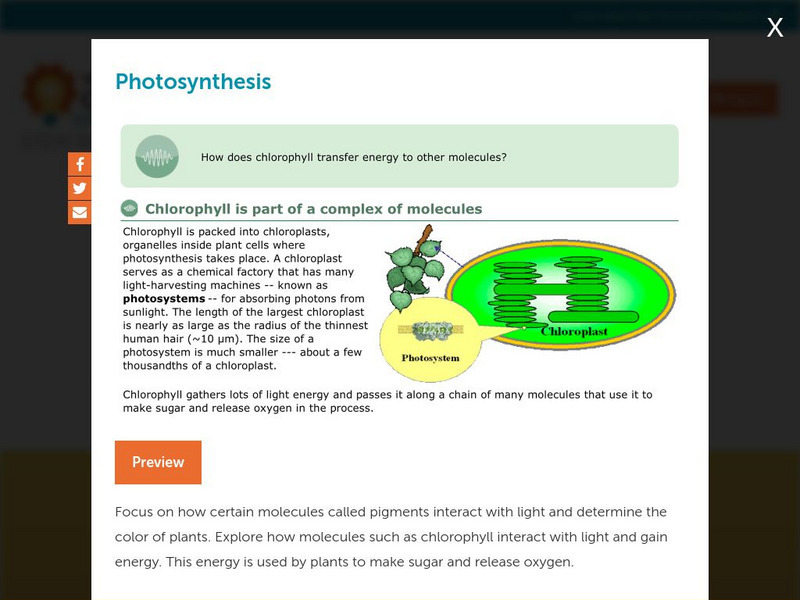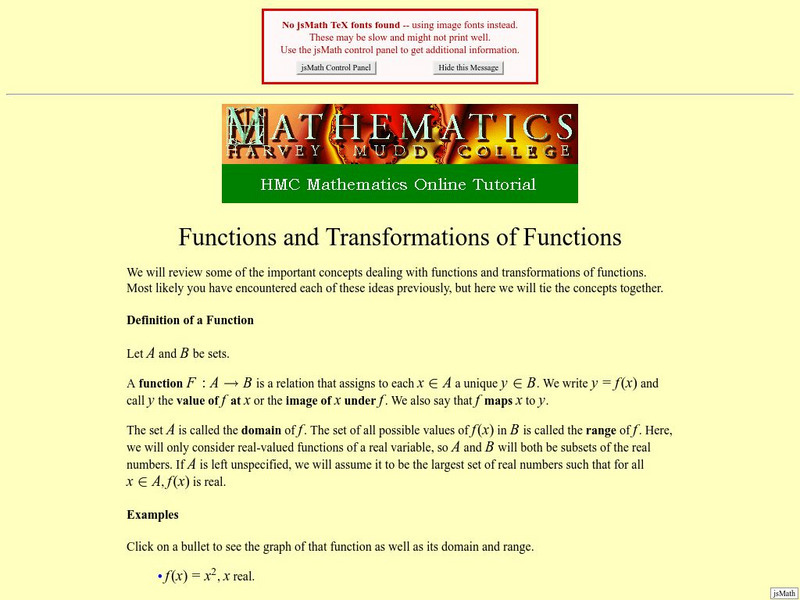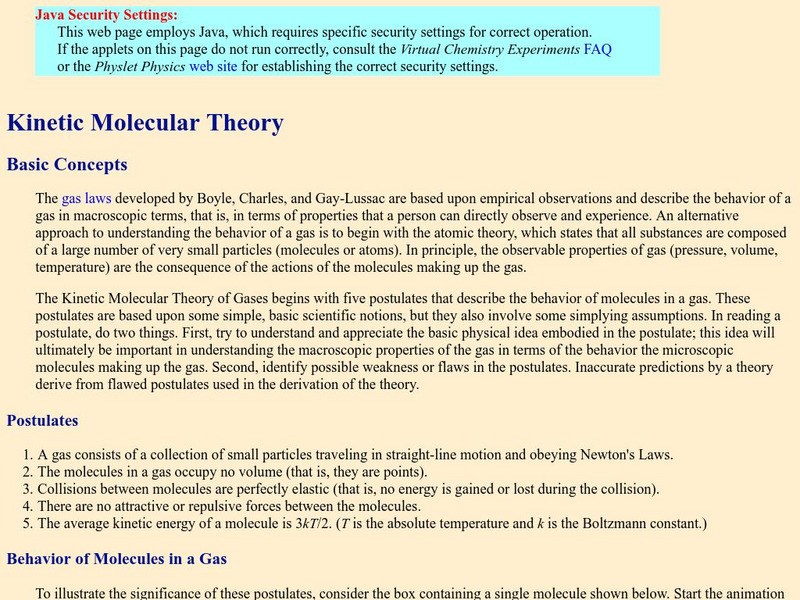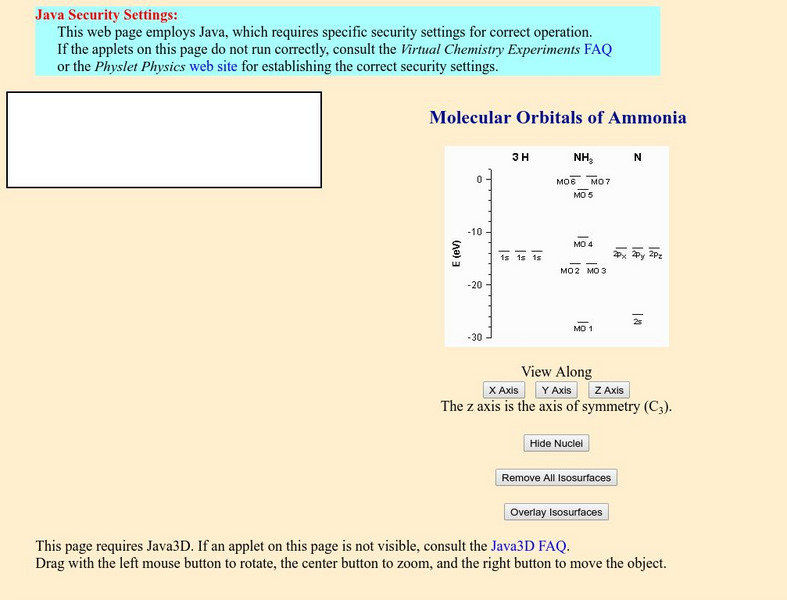Hi, what do you want to do?
Concord Consortium
Concord Consortium: Lipids and Carbohydrates
Focus on the basic structure and function of both lipids and carbohydrates, two of the four major macromolecule families in biological systems. (Requires Java)
Concord Consortium
Concord Consortium: Photosynthesis
Focus on how certain molecules called pigments interact with light and determine the color of plants. Explore how molecules such as chlorophyll interact with light and gain energy. This energy is used by plants to make sugar and release...
Concord Consortium
Concord Consortium: Catalysts
Students explore homogeneous catalysis. (Requires Java)
Quia
Quia: Figurative Language Quiz
This 30-question quiz asks students to answer questions about figurative language by selecting the correct answer. Feedback is provided after the quiz is submitted. Java is required.
California State University
Cal State San Bernardino: Bivariate Distribution Applet
The applet is a target at which green darts are shot either with a strict correlation to each other or without -- the user defines this. A good example of how bivariate data is truly influenced by two variables, possibly dependent upon...
Davidson College
Davidson College: Network Solids: Crystalline Solids
Explains the differences between ionic, molecular, metallic, and network crystalline solids. Displays structures for diamond, graphite, fullerene, and silica, accompanied by questions about their chemical bonding. Electron density plots...
Davidson College
Davidson College: Chemical Equilibria
Explains what chemical equilibrium is and the role of the Law of Mass Action. A Java simulation shows the concentration-time curves of a chemical reaction.
Other
Matter Project: Seismic Waves
Seismic waves are studied to better understand the ground beneath us, the layers of Earth and points of interest for earthquakes. Better understand the types of waves, what substances they may travel through and how, and gain a clearer...
Harvey Mudd College
Harvey Mudd College: Functions and Transformations of Functions
A review of the important concepts dealing with functions and transformations of functions. Java plug-in is required for the exploration feature.
Davidson College
Davidson College: Molecular Orbitals of Tetraamminecopper(ii)
A Java applet displays the Ligand Field Theory energy diagram for the Tetraamminecopper(II) ion. When an orbital in the diagram is clicked on, the isosurface is shown.
Davidson College
Davidson College: Sizes of Atomic Orbitals
Using a Java applet, sets of atomic orbitals are compared with different quantum numbers in order to compare the orbital sizes.
Davidson College
Davidson College: Visualization of Atomic Orbitals: P Orbitals
Discusses the geometry of the p orbitals and presents exercises for exploring their shape and orientations. Requires Java.
Davidson College
Davidson College: Visualization of Atomic Orbitals
Discusses the geometry of the d orbitals and presents exercises for exploring their shape and orientations. Requires Java.
Davidson College
Davidson College: Effective Nuclear Charge
Explains what Slater rules are and presents exercises for exploring how they are used to estimate the effective nuclear charge and how well they work compared to the Bohr model expression for orbital sizes. Requires Java.
Davidson College
Davidson College: Effective Nuclear Charge
Explains what the effective nuclear charge is and how electrons can create a shield between a nucleus and an outer electron. Presents exercises for comparing orbital sizes with effective nuclear charges. Requires Java.
Davidson College
Davidson College: Visualization of Atomic Orbitals: S Orbitals
Discusses the geometry of the s orbitals and presents exercises for exploring their shape and orientations. Requires Java.
Davidson College
Davidson College: Phase Changes: Phase Diagram: Part 5: Critical Point
Explains what the critical point in a phase change is and ways that a transition from a liquid to a gas can take place. Students investigate the concepts using a Java simulation.
Davidson College
Davidson College: Kinetic Molecular Theory: Basic Concepts
Discusses the basic concepts of kinetic molecular theory and presents animations illustrating the behavior of molecules in a closed box. Requires Java.
Davidson College
Davidson College: Valence Shell Electron Pair Repulsion (Vsepr) Model
Presents exercises where students can check their understanding of the Valence-Shell Electron-Pair Repulsion Model by predicting what a molecular shape will be. Requires Java.
Davidson College
Davidson College: Molecular Orbitals of Ammonia
A Java applet shows a molecular orbital representation of ammonia. When an orbital in the diagram is clicked on, the isosurface is shown. The orbitals for other molecules can be accessed through links at the bottom of the page.
Davidson College
Davidson College: Le Chatelier's Principle: Effect of a Change in Temperature
Explains how Le Chatelier's Principle is used to predict how a temperature change affects a system's chemical equilibrium and presents a virtual experiment where the effect is explored. Requires Java.
National Council of Teachers of Mathematics
The Math Forum: Paper Folding Activity
This is a lesson plan of paper folding as a method of proof. A Java applet version of the activity can be accessed, giving the actual lengths and angle sizes.
Davidson College
Davidson College: Valence Shell Electron Pair Repulsion (Vsepr) Model
Explains the principles of the Valence-Shell Electron-Pair Repulsion Model, and gives examples of the geometry. Requires Java.
National Institute of Standards and Technology (NIST)
National Institute of Standards and Technology: Insertion Sort
Provides a clear definition of an insertion sort with links to a Java implementation and other demonstrations.
Other popular searches
- Computer Science Java
- Java Applet
- Java Text
- Java Script
- Java Programming
- Software Tutorials Java
- Javascript
- Javanese Shadow Puppets
- Java Computer Language
- Java Applet1
- Sumatra and Java
- Computer Science Java Array



















